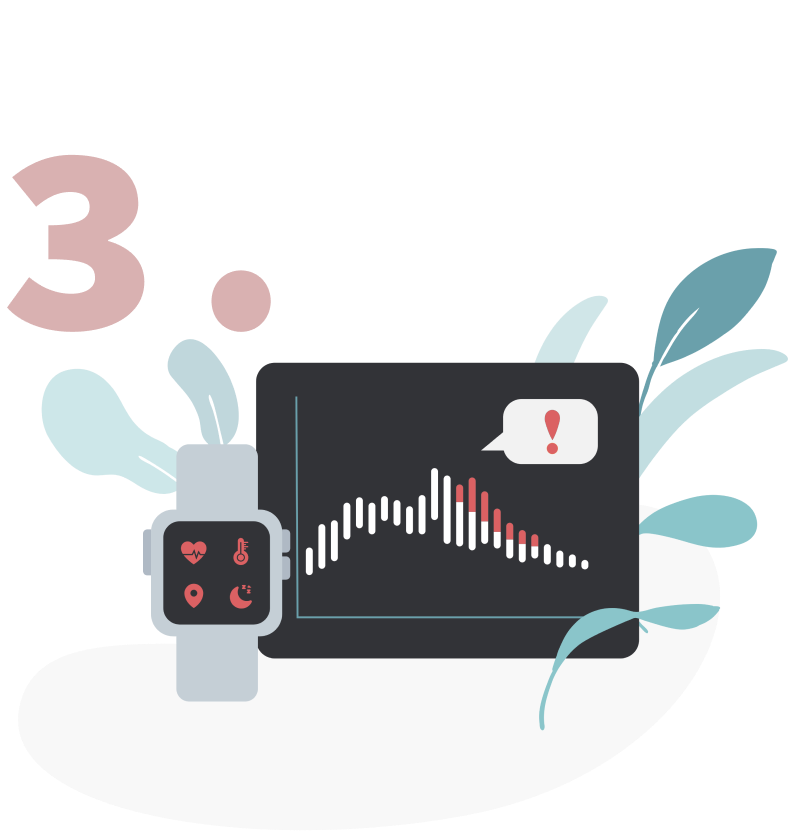Infectious Disease and COVID-19 Wearables Study
With limited test kits and slow results turnaround, we are trying to find out if information from wearable devices can help detect Infectious Disease or COVID-19 before symptoms emerge.
Enroll here, or download the MyPHD app to begin:



WHO SHOULD JOIN
We welcome you to join if you meet the following criteria, regardless of your vaccination status:
- Own a wearable device that measures heart rate (eg. Fitbit, Apple Watch). Find out if your wearable device is compatible:

- Are 13-80 years of age;
- Do not have any known cardiac conditions:
Coronary artery disease or history of myocardial infarction, brady- or tachyarrhythmias, valvular disease, cardiomyopathy, etc. - Do not wear cardiac devices:
Implanted cardiac monitor, pacemakers, defibrillators, etc. - Are not pregnant.
Prefer to enroll now, and download app later?
If you own a device that is not compatible, please email us at wearables_validation@stanford.edu

HOW IT WORKS

Collect Data
Our research in 2017 shows data collected from wearable devices can detect infectious illness days before symptoms emerge.

Develop Algorithms
Our algorithm picks up abnormal patterns that deviates from your baseline to predict infection onset.

Validate Algorithms
With your help, we are testing our algorithms to see if we can accurately predict infection onset.
OUR VISION

WHAT YOU WILL DO

1. Download the app and enroll.
Download an app, developed by Stanford University School of Medicine, that will allow us to collect data from your wearable device.

2. Wear device & answer surveys.
Continue to wear your wearable device to keep track of your health data, and tell us about your symptoms and circumstances via the app.

3. Collect samples at home.
As the study progresses, we will ask some participants to collect samples at home.
WHAT WE PROMISE
A gold standard for safety
Our data collection app MyPHD was designed based on Stanford’s gold-standard of data privacy and security. Your data is safe with us. FAQ ↓
Your data is secure
This study has been approved by the Chief Security and Privacy Officers of Stanford University, and has been rigorously vetted by the Stanford Institutional Review Board.


Your contribution is valuable
Your data directly contributes towards validating our early infection warning system. This could support a safer re-opening of the economy, since it would allow people to self-isolate as opposed to unwittingly spreading the disease when they are pre-symptomatic or asymptomatic.
You are in good company
We are proud to join force with industry leaders like Garmin and Fitbit to improve healthcare for everyone.
We are here for you
Your participation is voluntary and you have the right to withdraw your consent or discontinue participation at any time. We also are happy to answer your questions.

FREQUENTLY ASKED QUESTIONS
1. Participation Eligibility & Enrollment

Am I still eligible to enroll if I have already received a COVID-19 vaccine or plan to get a COVID-19 vaccine?
Yes, you are eligible to enroll, even if you have already been vaccinated or plan to get a COVID-19 vaccine.
How do I get enrolled in the study?
Please start enrolling by clicking on the Apple Store or Google Play buttons at the top of this page and downloading the MyPHD app. Click here to watch an overview tutorial.
You’ll be redirected to our consent form page, where you can read more about what is involved and decide whether you agree to take part.
If you decide to enroll in the study, the whole process may take approximately 10-15min of your time. Please make sure to complete all of the surveys.
The MyPHD app, where you can easily link your wearable devices, is created by our bioinformatic team at Stanford University.
We will use it to collect data from your wearable device and your daily symptom information to track onset and progression of infectious diseases, including the COVID-19. We will also use the app to send you alerts via push notifications and ask you to report circumstances back to us.
I’d like to participate, but I don’t want to wear my wearable device all the time.
Please still consider enrolling, and wear your device as much as is possible/comfortable.
As much information as we can collect is valuable, although we appreciate that it might not be possible for you to wear your device all the time.
Can my friend/spouse/family member enroll too?
If they meet the eligibility criteria, they can enroll on this page.
Please do not provide the friend/spouse/family member’s contact details to us. For privacy reasons, we cannot reach out to them directly. Please ask them to visit this webpage to find out if they are eligible.
Does this study enroll non-English speakers?
Currently, we can only enroll people who live in the U.S.A or Canada and can consent in English. If you can read and understand the consent form in English, please go to our website to enroll. We hope that in the future we can include other languages too.
I’d like to participate but I don’t own a wearable device. Can you provide me one?
If you are not eligible for Phase II of our COVID-19 Wearable study or you do not own a compatible or wearables device, You may be eligible for one of our other studies. Learn more and enroll here >
I forgot to enter some information in the enrollment survey. What should I do?
Please email us the information at wearables_validation@stanford.edu and we will enter it in the survey for you.
2. How to Participate & What to Do During The Study

What is the purpose of this research study?
You are invited to participate in a research study to evaluate the use of algorithms from wearables data to predict onset and progression of respiratory infection.
In our previous study, we developed an algorithm that can correlate changes in physiological parameters (such as heart rate) with onset of infectious disease(s). We hope that this algorithm can be used to warn people that they are getting sick, even before any symptoms start. The purpose of this study is to test this algorithm. We will do this by sending participants an alert when we detect a change in their physiological parameter(s). After receiving the alert, participants will be asked to report circumstances back to the research team. This will help us to understand whether the algorithm is detecting the onset of infection(s), or if there is another reason for the physiological change (eg heart rate change because of watching a scary movie, stress, medications).
Can I participate in the study without signing a research consent form or Authorization to Use Your Health Information For Research Purposes form?
No. Information about you and your health is personal and private, it cannot be used in this research study without your written authorization. Your information will only be used in accordance with this authorization form and the consent form and as required by law.
I had symptoms previously. How should I enter that information?
Once you enroll, you will be prompted to complete several surveys, one of which will ask about past symptoms. It would be very helpful if you include in that survey whatever you can remember about your previous symptoms.
How long do I need to keep completing the surveys / sharing my wearables data?
It would be valuable to collect the wearables data for up to 2 years to understand how COVID-19 impacts long-term health. However, your participation in the study is entirely voluntary and you can withdraw from the study at any time.
Can I change my device during the study? (i.e., can I buy a new Fitbit or do I have to keep using my old one?)
You can change your device during the study as long as it is a device supported by our app. Please make sure to select your new device as your primary device on the MyPHD app.
I want to withdraw. What should I do?
Click “Unsubscribe” at the bottom of your Weekly Reminder email, and follow the prompts to withdraw from the study.
What do I do during the study as a participant?
Click here to watch an overview tutorial video.
Taking part in the study will involve:
1 – Downloading an app, developed by the Snyder lab at Stanford University, that will allow us to collect the data from your wearable device;
2 – Telling us about your symptoms and circumstances using the app when asked;
3 – We will ask some participants to collect some samples at home if they choose to.
We will ask everyone to report their health status at least once per month using the app.
We will ask you to continuously wear your device and share the data collected by the device with the study team. The devices will be worn or used every day, for up to 24 hours per day, up to 24 months. You will be able to remove the devices for part of each day as needed and when you feel comfortable doing so.
The study-related app that we will ask you to download will give us access to your wearable device data remotely. You will receive instructions via email on how to properly install the app and how to sync it to your wearable device(s) app, so it can securely collect your data. If you are using a Fitbit device, Stanford will have access to data about your activity (including steps distance, calories burned, and active minutes), heart rate, location, nutrition, sleep, weight, heart rate variability (HRV), Fitbit cardio fitness score, off wrist time, and sedentary time.
We will analyze data from your wearable device with the symptoms and circumstances you report to us. We will also gather your health information by asking you directly or by looking at your electronic medical record if you agree. You have the right to refuse to answer particular questions.
If you are participating in other Stanford research study(ies), we will ask for your permission to obtain and analyze research data collected from that research study if that study allows for the sharing of your research data.
3. Consent, Authorization & Data Privacy

What data is being collected?
We will collect data from wearable devices, such as step count, body movement, electrical changes in the skin related to stress (galvanic skin response, GSR), skin temperature, your location (global positioning system, GPS), the amount of oxygen in your blood, your blood pressure, the quality of your sleep.
In addition, we will ask you to report past and current symptoms (eg. fever, sore throat) via symptom survey on the MyPHD app.
Additionally, if you agree, we would ask your permission to collect medical record information from you.
How will my personal data be stored?
The data will be secured by Stanford University and only accessed by the study team.
How does the study protect my privacy when data is released/disclosed?
Once your identifiers (such as name, date of birth, address etc) are removed from the research data, the research data may be shared publicly. For example the research data may be put in a public database for other researchers to use.
In simpler words, is my data secured?
The data will be collected from the wearable device(s) itself or the device company’s server and stored on secure Stanford University servers. In the context of the MyPHD app, which has been data risk approved by Stanford University, we have established a secure computational and storage framework to minimize any risks to your privacy.
Who may receive, use or disclose my health information?
Aside from the research team, some other parties may need to have access to some study information. More details are provided in the consent form.
The following parties are authorized to use and/or disclose your health information in connection with this research study:
- The Protocol Director Dr. Michael P Snyder
- The Stanford University Administrative Panel on Human Subjects in Medical Research and any other unit of Stanford University as necessary
- Research Staff
4. Contacts for Questions, Concerns & Complaints

Who should I contact if I’m not satisfied with how this study is being conducted, or if I have any concerns, complaints, or general questions about the research or my rights as a participant?
Please contact the Stanford Institutional Review Board (IRB) to speak to someone independent of the research team at 650-723-2480 or toll free at 1-866-680-2906. You can also write to the Stanford IRB, Stanford University, 1705 El Camino Real, Palo Alto, CA 94306.
Who should I contact within the research team for questions, concerns or complaints about this research study?
If you have any questions, concerns or complaints about this research, its procedures, risks and benefits, please contact the study team at wearables_validation@stanford.edu.
5. The MyPHD App

What is the MyPHD app?
The study app, where you can easily link to supported wearable devices, is created by Dr. Snyder’s lab at Stanford University. It is used in this study to collect physiological data from your wearable device and correlate this with any symptoms you report. Within the app, there is a weekly symptom/check-in survey (daily if you are symptomatic), which should take no more than 1-2 minutes to fill out.
Click here to watch an overview tutorial.
What should I do if the app crashes?
This issue can be solved by un-installing and then re-installing the app. We are constantly working on improving the app.
Is the app available for iOS and Android?
Yes, the app is available for iOS and Android.
How do I share my wearables data with the research team?
We will send instructions on how to securely download and use our study app. When the app is installed on your phone, we will be able to collect your wearables data. It is important that you install and use the app properly, as that is the only way for us to collect your wearable data remotely.
I’m confused about how to download, log in, and use the app. What do I do?
Click here to watch an overview tutorial. You can also watch a video which goes through the instructions for downloading, installing and using the app: MyPHD_Tutorial. If after watching the tutorial video, you still have questions, please reach out to us at wearables_validation@stanford.edu
RELATED RESOURCES
4YOUANDME
Study: Stress & Recovery in Frontline Healthcare COVID-19 Workers
If you are a frontline health care worker, you might be interested in a companion study being hosted by 4YouandMe that looks at Stress and Recovery and offers OURA rings to the first 400 participants
FITBIT
COVID-19 Resource Hub for the Fitbit Community
Fitbit is introducing a new tab in the Fitbit app to give users access to helpful information, motivation, and resources about COVID-19.
Survivor Corps
Survivor Corps is a grassroots movement connecting, educating and mobilizing COVID-19 survivors with the medical, scientific and academic research community, to help stem the tide of this pandemic and assist in the national recovery.
Stanford & COVID-19: How You Can Help
Stanford is working urgently to treat patients, conduct vital research, support our community, and advance all fronts of the global response to the COVID-19 outbreak. Find out how you can help.
Become a lab insider.
Sign up for our newsletter and be the first
to hear about new studies in development.
Subscriber Benefits
Connect
COVID-19 Wearables